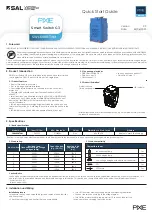
1-12
z
The
mtu
command is not recommended. It affects only parameter negotiation, which may occur; it
does not affect data forwarding.
z
With Kompella MPLS L2VPN, you must create on the PE an L2VPN instance for each VPN where
a directly connected CE resides. When creating an L2VPN, you must specify an encapsulation
type matching that of the CE side interface.
z
The configuration of the VPN targets and RD are the same as that for MPLS L3VPN. For Kompella
MPLS L2VPN, the RD is required. Once configured, an RD cannot be changed, unless you delete
the L2VPN and then re-create it.
Creating a CE Connection
CE ID is used for identifying a CE uniquely in a VPN. To facilitate the configuration, it is recommended to
encode the CE IDs in continuous natural numbers starting from 1.
The CE range of a VPN indicates the maximum number of CEs that can be connected to the VPN. You
can configure a CE range greater than what is required based on your estimate of the future VPN
expansion if the label resources are abundant (they are usually abundant). This can reduce the
configuration modification required when CEs are added in the VPN in future.
When creating a CE connection, if you do not specify the CE offset, the following are true:
z
For the first connection of the CE, the CE offset is the value specified by the
default-offset
parameter in the
ce
command.
z
For any other connection of the CE, the CE offset is that of the former connection plus 1.
z
When planning a VPN, you are recommended to encode CE IDs in incremental sequence starting
from 1. When configuring connections, you are recommended to adopt the sequence of the CE IDs,
in which case you can omit the
ce-offset
portion from most of the required commands. This
simplifies the configuration.
Note that you can only increase the CE range. For example, if the original CE range is 10, you can
increase it to 20, but cannot reduce it to 5. The only way to reduce the CE range is to delete the CE and
re-create it.
When you increase the CE range, for example, from 10 to 20, the system does not release the original
label block and then re-apply for a new label block of the size of 20. Instead, the system applies for a
supplementary label block of the size of 10. This ensures that the existing services will not be
interrupted.
Follow these steps to create a CE connection:
To do…
Use the command…
Remarks
Enter system view
system-view
—
Enter MPLS L2VPN view
mpls l2vpn vpn-name
—
Create a CE for a VPN and
enter MPLS L2VPN CE view
ce
ce-name
[
id
ce-id
[
range
ce-range
] [
default-offset
ce-offset
] ]
Required
Summary of Contents for S7906E - Switch
Page 82: ...1 4 DeviceA interface tunnel 1 DeviceA Tunnel1 service loopback group 1...
Page 200: ...1 11 DeviceB display vlan dynamic No dynamic vlans exist...
Page 598: ...ii...
Page 1757: ...4 9...
Page 1770: ...6 4...
Page 2017: ...2 11 Figure 2 3 SFTP client interface...
Page 2238: ...1 16 DeviceA cfd linktrace service instance 1 mep 1001 target mep 4002...
















































